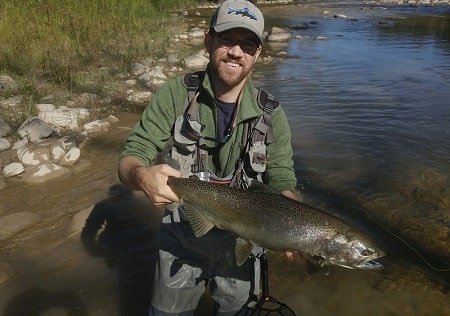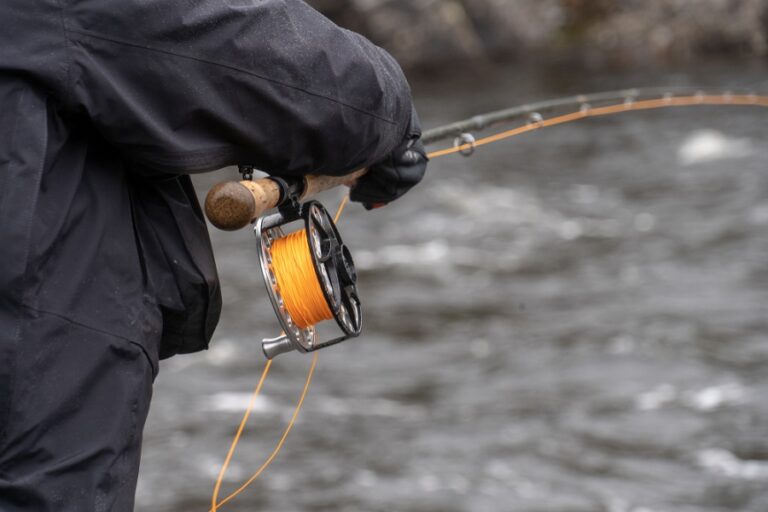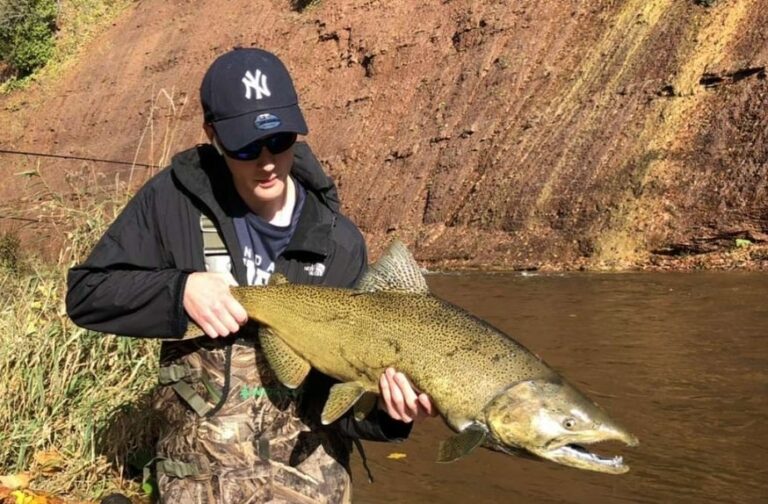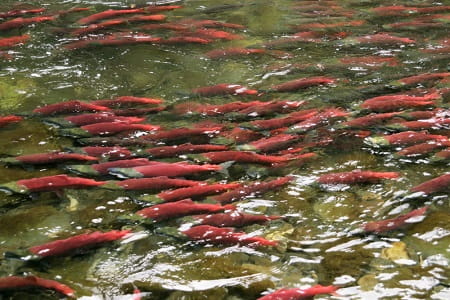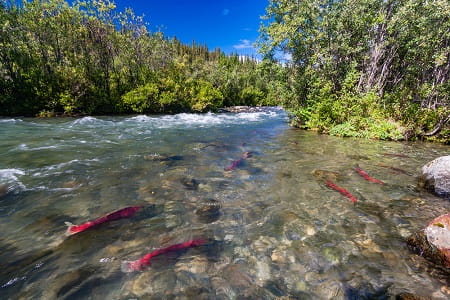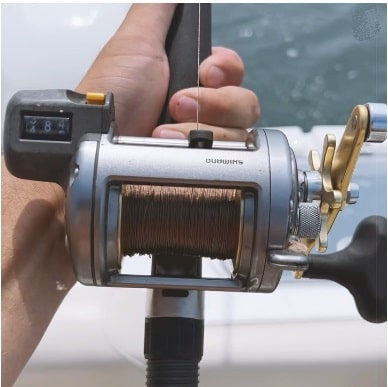Side Drifting For Salmon: Complete Guide and Setups
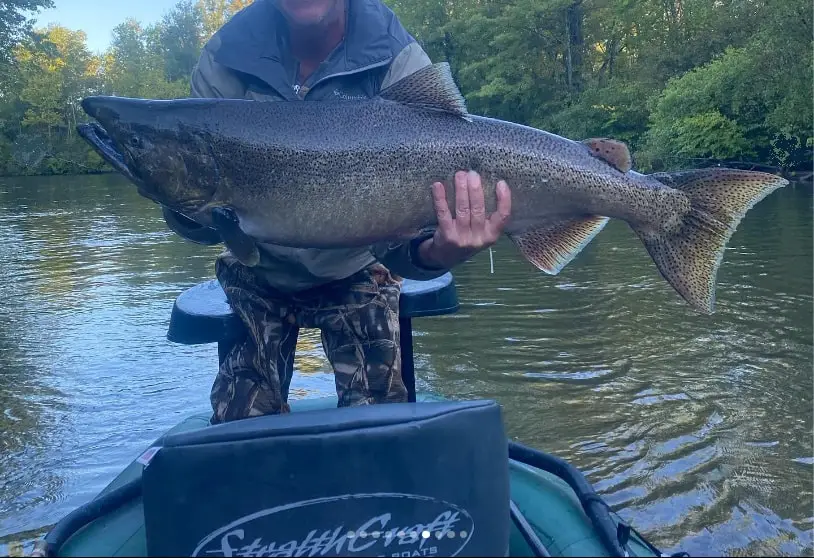
Side drifting for salmon is a boat fishing method where the boat drifts in a controlled manner at the same speed as the river while the angler drifts a bait out of the side of the boat through the target area.
The great thing with side drifting is that you can cover a lot of water.
When I’m guiding and teaching clients how to catch salmon using the side drift method, I explain that there are four things that are keys to successful side drifting for salmon.
- Boat control
- The drift rig setup
- Presenting the drift rig properly
- Detecting the bite.
Other important factors come into play, such as using the right gear, the right bait, and even knowing where to fish. All of this will be discussed in this article.
Side drifting for steelhead is also very effective.
Gear For Side Drifting From A Boat
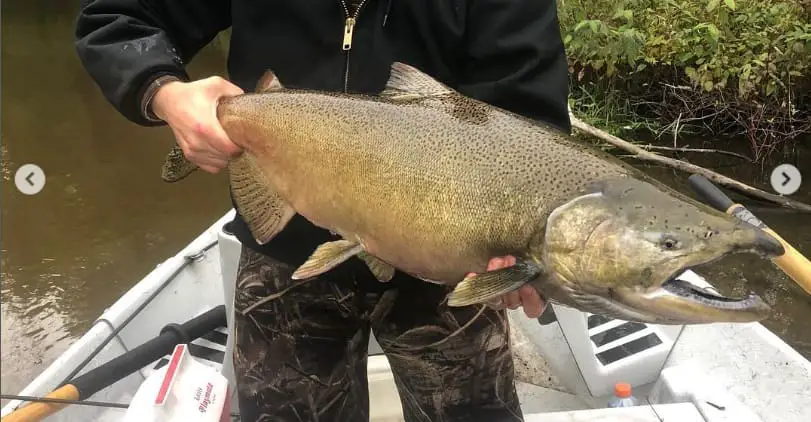
There are a bunch of things you will need to do side drifting well.
The Boat
You need a boat to side drift otherwise, if you do this method from the bank it is called drift fishing.
I fish in smaller rivers that are also shallow in areas, and the best boat is either a drift boat, a pontoon boat, or an inflatable raft.
On larger rivers that are mostly deep, a power boat with or without a kicker motor or trolling motor will work.
Rod Selection
The best rods for side drifting salmon are medium action, 9 to 12-foot rods, with a sensitive rod tip to aid in strike detection. Ideally, you want a fairly lightweight rod since the sinker weight rig is light.
A longer rod helps keep all the line up off the water, especially when fishing further away.
Good options are G. Loomis GLX Classic Salmon & Steelhead Drift Spinning Rod, the Lamiglas X-11 Salmon & Steelhead Casting Rod, and for a budget rod, the Daiwa Northcoast SS Side Drifting Spinning Rod
Reel Selection
Any large line-capacity spinning reel with a smooth and strong drag system will work for side drifting. I’ve seen plenty of guides and anglers using the inexpensive Pflueger President or Pflueger Supreme Spinning Reels. You could also use my most recommended spinning reel, which is the Shimano Stradic.
Many anglers also like baitcasting reels for this method. Both a low profile baitcasting reel and round baitcasting reels are good. Bait casting reels are preferred for similar methods like back bouncing and back trolling.
Line
The manline for salmon will depend on if you are targeting big salmon like Kings or smaller salmon like Coho or Chum salmon. Either way, a monofilament high-viz line is best, and I’d say you are safe for all salmon with a 16 to 20-pound line.
When fishing Great Lakes salmon, I use 12 to 14-pound lines.
The reason for high-viz or brightly colored lines is so other guys around you can see your line, so you don’t cross lines.
As a guide who teaches thousands of fishermen, for most methods like drift fishing and float fishing, it’s also easier to teach proper line control with a brightly colored line. With the right leader setup, the fish will not see the bright line.
Leader or Dropper Line
The leader or dropper line used is two to four pounds lighter than your mainline. Some fishermen and guides like me prefer lighter leaders that won’t be seen by the salmon.
For West Coast salmon, 12 to 16-pound leaders or dropper line is best.
For Great Lakes salmon, I use 10 to 14-pound leaders.
Terminal Tackle
For your side drift rig, you will need a 6mm stopper bead, a barrel swivel, and a snap swivel.
Hooks
Many anglers like large hooks from 4/0 to smaller size 8 hooks. I always say to match your kook to the bait size so the hook is not seen as easily. Smaller bait, smaller hook, bigger bait, bigger hook.
Personally, I think most fishermen use hooks that are way too big when salmon fishing.
I also find it interesting that anglers around the Great Lakes region, fishing for twenty to forty pound chinook salmon use hooks between a size four and size 8, while anglers on the West Coast fish for the same size fish with much larger size 2/0 to size four mostly.
I’ve caught thousands of large chinook salmon on size 6 and 8 hooks.
Weights – Pencil Lead Weight Or Slinky Weight
You will need an assortment of pencil lead weight or slinky weights in various weights to keep you in the strike zone. A slinky is multiple round weights stuffed into a parachute cord, and the reason guys like a slinky is because it gets hung up less and you can go from lightweight to heavy weights easily.
You will need to adjust your weight based on the depth and current speed so the weight glides and bounces along the bottom. Too much weight will not allow the bait to drift naturally and will get hung up more often.
If you are catching or dragging the bottom too much, use less weight.
Best Baits
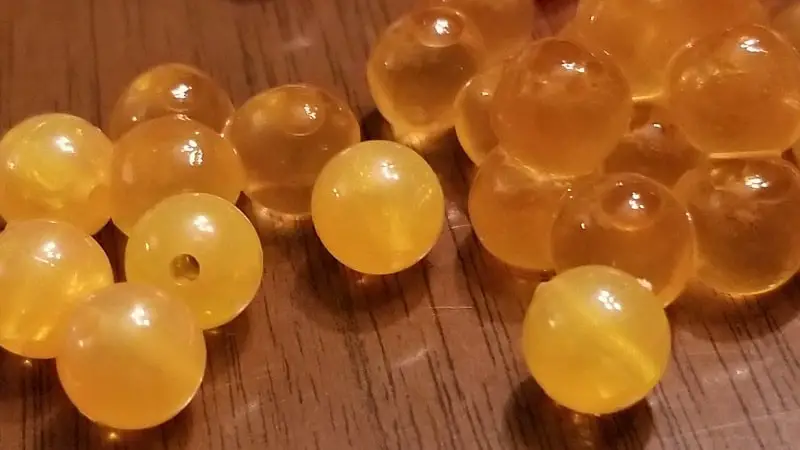
Almost any bait that you would use for float fishing, drift fishing, or plunking will also work with side drifting.
The only thing to consider is that often a bait float is required to keep the bait up and off the bottom. Anglers will use a Roe Rig, which is two hooks inline with a floating bead or corky between the hooks to keep the bait floating up off the bottom. Salmon roe is most commonly used.
Salmon Drift Fishing Baits Include:
- Roe Bags
- Skein
- Plastic worms
- Shrimp
- Flies
- minnows or baitfish
The Side Drifting Rig – Rigging It All Up
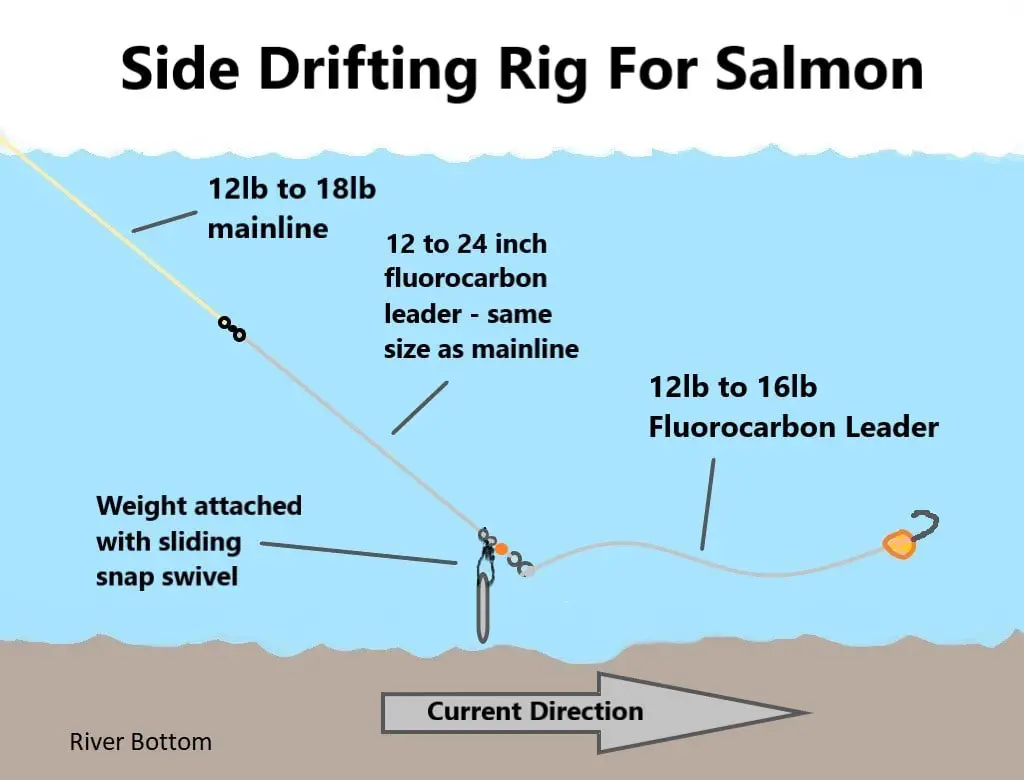
Controlling The Boat
One of the most important things in drift fishing is boat control. There are three key things regarding boat control.
1. Keep The Nose Downriver: You want to be able to keep the nose of the boat downriver so the boat is perpendicular to the shore or spot you are fishing.
2. Stay Beside The Fish: You want to also keep your boat off to the side of where you believe the salmon are holding or moving through.
3. Control Your Speed: You also want to control the speed of the boat so you are matching the speed of the weight bouncing along the bottom, which can be slower than the actual surface current.
Keeping the boat straight bow downriver and sideways to where you are fishing is even more important when fishing with multiple anglers and multiple rods. Experienced anglers know not to cast upstream and across other anglers lines while the boat is moving downstream.
If using a trolling motor keeping the bow and trolling motor upriver is best to slow the boat down and keep it moving in a straight line.
Doing The Side Drift Presentation
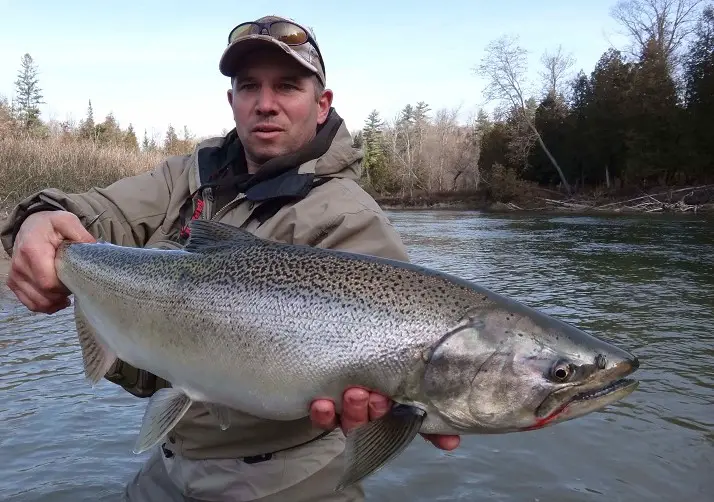
Presentation is key when fishing with all methods, and side drifting is no exception. Follow these steps for side drifting for salmon if you want maximum results.
1. Fish Productive Water: Read the water before you fish the pool to determine the best water for the salmon to be holding or moving through.
2. Position the Boat: pick your line upstream of where you think the salmon will be and stay beside the fish.
3. Cast Out: Cast only far enough to get your bait into the best zone
4. Get To The Bottom: It should take 2 to 4 seconds for your weight to hit the bottom. You may feel it with the rod tip, or you may see the line stop when the weight hits the bottom. Detecting the bottom is a critical skill and part of the learning curve. You should be able to feel the weight tapping the bottom.
5. Don’t Pull: Keep the rod tip and the line up and semi-tight to keep all slack out of the line and try to feel the weight bounce across the bottom.
6. Detecting The Bite: With the semi-tight line, you will feel a pull or tug on the line. This can be a salmon biting or the weight getting hung up. Either way, give the line a little pull. Doing so will either release the weight from the bottom or tighten it, which indicates a bite or a severe snag.
7. Set The Hook: Once you feel the salmon pulling, set the hook hard and fast with an upward and sideways motion. A good hookset makes a big difference.
The Bite And When To Set The Hook
For new anglers, one of the more difficult things is determining fish bites versus bottom. With time, you will figure it out.
A slow, steady pull is often just the bottom.
A faster pull or irregular pull is often a salmon biting. When you feel the bite, the salmon has it in its mouth. Although some anglers say to wait a couple of seconds to let the salmon chew the bait and get it deeper in the mouth, my experience is to set the hook hard the second you realize it’s a fish.
As you get good, you will be detecting the bottom with consistent taps as your weight drags, if those taps stop, you are hung up or have a bite.
When Coho salmon fishing, remember that coho bite more aggressively and will often run at the boat so be prepared to reel fast.
Dealing With Snags Like A Pro
Snags can break your rod! So you must deal with them properly, and there are two ways to deal with a snag.
1. The second you determine you are snagged, drop your rod and point it at the snag, open the bail or free spool the bait casting reel so you put slack in the line, then tighten and lift fast a few time to hopefully jiggle the weight free from the rocks. If this doesn’t work, use option two.
2. Point your rod tip at the snag, hold the spool, or put your thumb on the spool to tighten it until the boat pulls and snaps the leader.
Tips For Fighting Fish
Often, when drift fishing, multiple anglers will have multiple rods and lines in the water simultaneously. When dealing with larger fish, all other anglers should immediately reel in their lines so as not to get tangled.
Should another angler’s line get tangled with a fighting fish, the anger that is not fighting the fish should loosen the drag very loose to let the line out easily or free spool it, and then reel in slack as the fish comes in. Doing so will help the other angler catch the fish.
Pro Tip For Side Drift Fishing
- Pre-tie leaders in advance
- Have your weights organized by size
- Have an extra rod or two pre-rigged and ready to go in case a big king salmon beaks a rod.
- This is for any salmon fishing, not just when you drift fish. Rotate baits. If one bait is not producing, try other baits, other sizes, or colors of the same bait.
- Fish everywhere and pay attention to patterns or places where salmon are seen or caught. If all the salmon are held up in pools, focus on pools. If they are in pocket water or by big boulders, look for more fish in similar spots.
The Downside To Side Drifting
I’ve been known to park myself in a pool or run for a long time and thoroughly fish it. Doing so has allowed my clients to catch ten times more fish than other guide boats that drift by quickly, and I’ll explain why.
If you drift through a run with 10 or 20 salmon, and one or two anglers in the boat hook into a fish, if you don’t stop the boat, by the time they land their fish, you will have drifted over and past all those other salmon. You will miss them. And I have seen days, especially between runs when salmon are holding in select pools, and some pools will be stacked full while most of the river is void of fish.
Side drifting does cover miles of river, but you only get one pass and one shot at each pool or run, which means you could be missing a lot of fish.
At times, I have been known to stop the boat at the end of a great run, paddle back up to the top, and do it again.
Boondogging For Salmon From A Boat
Boondogging is a slight variation of side drifting. With Boondogging, instead of pointing the nose of the boat upriver or downriver while having the anglers fish beside the boat, Boondogging turns the boat sideways so the nose of the boat is pointed toward shore and the angler fish out of the upriver side of the boat.
Casting upriver out of the side of the boat drags the bait rigs down the river.
This works best in deep water where the salmon won’t get spooked by the boat going over them first.
In my opinion, side drifting is better and more effective, especially with clear water clarity and shallower water.
Best Dragging/Side Drifting Water
The best water for side drift fishing is anywhere that salmon will hold. Often, slower water and deeper water are good for the salmon to slow down and rest. And slow and resting salmon are more likely to eat.
Salmon tend to move fast through shallow water, so this is not always good for drift fishing.
Large rocks in the middle of the river are a sweet spot. Drift your pencil lead beside and behind the rocks.
Travel routes are something I learned to look for on smaller rivers. Larger rivers that are shallow can also have travel routes.
Travel routes are generally areas where the river is deepest and has good currents. Bubble lines are also travel routes as salmon and steelhead will stay out of the really fast water and follow these softer seams and bubble lines.
Seams are areas between the faster water and the slower water, and I see them on any shallower river.
Side Drifting With Flatfish
An alternative method that can be very effective is to use an F7 Flatfish plug or similar-sized Kwikfish plug and drift it along as if it were a bait. In areas with lots of fishing pressure from bait fishermen, this method can be very effective.
Cast out, let the weight hit the bottom, and start dragging the bottom. The plug will swing downriver and start to wobble.
The salmon will hit the plug in a similar fashion to hitting a bait with a more subtle take. Hard yanks are possible.
Drift Fishing With A Bobber or Float Fishing
You can also do side drift fishing with a drift bobber or a float. Use a typical float fishing method with a suitable float or drift bobbers and enough weight for the depth and current speed. For deeper water, go with a slip float and more weight.
I use a fixed float when fishing shallow water. Use the right size float for the type of water you intend to fish and the amount of weight you need to use. Too much weight will sink smaller floats, so be sure you use a large enough float.
Side Drifting For Salmon Q&A
If you have a question, comment, or some advice on drift fishing for salmon, let us know in the comments section below.
Tight Lines
Graham

